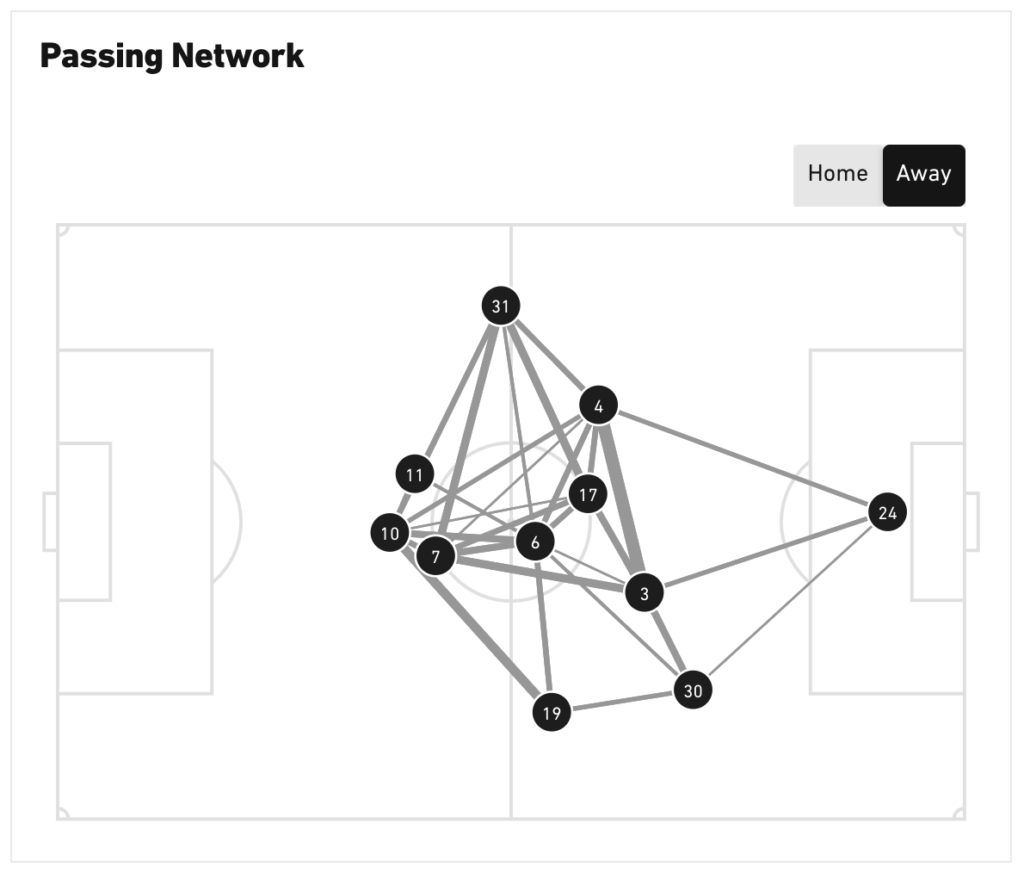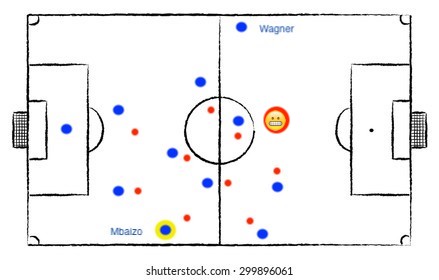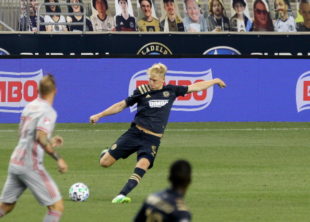Photo by Paul Rudderow
Montreal stole two points from the Union in a match where the Union themselves were playing the role of Ocean’s 11 (Ocean because it was raining and they were trying to steal something, and eleven because… well, you get the idea).
They did so – at least in formation – by employing a tactic that has flabbered the gast of Union brass all season long: by playing either 3- or 5-in-the-back. On Sunday it was three, and here’s why that subtle change so quickly undoes the Boys in Blue.
When the Union have the ball
The Union are not a possession team.
Though they can flow when they need to, their mechanisms for creating creating chances rely on numbers advantages and 50/50 balls. The idea goes like this:
If the team can put a ball into a space where there’s a 50% chance of winning (like the endless supply of balls behind the opposition’s fullbacks that Sergio Santos runs onto), but that space contains more Union players than players on the other team (a part of the pitch where there are 3 Union players and only 2 opponents, for example), then that percentage isn’t 50% anymore but some other number in the Union’s favor (because the team win the balls they win, but also clean up the mess of some of the balls they don’t win). Do that enough and chances will come.
Opponents who use odd numbers in the back make this math more difficult.
With 3 in the back, the opposition can use one of their wide midfielders to address the Union’s attacking fullbacks without sacrificing the space behind them, the place where Sergio runs – that third player rotates high and the other two rotate over. Because there is essentially another person there compared to a shape with 4 in the back, the opposition can cover that vacated space and still have 2 “central” defenders.
Moreover, the Union’s options are limited in the build up as well.
Because their opposition has committed 7 players to pressing the ball high (irrespective of if the formation has 3- or 5-in-the-back, the wide players provide the final number), there are bodies to clog the spaces between the back line (or, if there are three passing lanes connecting the four Union defensive players, the opponent can put a body in each one, forcing the ball somewhere other than safely sideways). Thus, the Union are forced into 1) giving the ball to their fullbacks, who are already occupied, 2) passing the ball back to a harried goalkeeper, or 3) putting the ball into the midfield/down the field, both representing areas in which keeping possession is less likely.
It’s a Sophie’s Choice. A Catch-22. A Solomon and the baby, or the baby and the bath water – it’s some metaphor about hard decisions and Montreal forced a lot of them on the Union Sunday.
All is not lost however.
When the Union don’t have the ball
The Union don’t want the ball for any amount of time beyond what it takes to score a goal.
That’s hyperbolic, but the reason they take kickoffs and lump them into the corner isn’t because they’re trying to preserve possession – the rest simply flows from this thesis. Thus, advancing forward through the lines of a team with an odd-numbered back line or midfield can be done in minimal time via two distinct paths:
1. Lying in wait – the Union’s counterattacking goal just seconds after the half against Columbus is Exhibit A for turning defense into offense into a goal.

This is the Crew’s passing network, and as usual they are narrow and tight with the ball (even with thirty minutes of soccer up a man). Though that should play into the Union’s own narrow-shaped hands, the visitor’s skill in possession makes them difficult to dispossess. The weakness of course is in the instance they are dispossessed: just like in the goal scoring sequence, when the Crew lose the ball while staying compact in order to keep it – with some overlapping on the wings – there are often two lines of players chasing to recover and a third line running toward their own goal, each with their own man-mark.
It’s a recipe for disaster and the Union cooked it to perfection, with Alejandro Bedoya as Salt Bae.
In this example, the Union excelled. However, more broadly the Union have yet to find a reliable replacement for Brendan Aaronson’s speed in doing this job. He was the sous chef last season, getting everything prepped for delivery. This year, the service is simply too slow.
Both Jamiro Monteiro and Daniel Gazdag are too focused on dancing on the ball to effectively move it forward with pace right now, and the two youngsters who got starts on Sunday, Paxton Aaronson and Quinn Sullivan, are still a few months away from the kind of guile required to make this transition.
The opportunities are there.
2. Beating the overload – there are few things as scrumptious as a well-hit diagonal ball from a center back.
That the Union have a stable of defenders who can make these impossible passes is in itself an incredible blessing. An inherent weakness of an odd-numbered back line, especially one with a defensive focus on the kind of attacking fullbacks the Union employ, is switching play. Here is a simplistic example, assuming the Union have the ball with Olivier Mbaizo on the right side (blue circle with a yellow halo) and are facing a 3-4-3 like they did on Sunday:

The Union’s opponents have committed three players to the attack, eliminating safe passes across the back line when the ball goes wide – a standard pressing cue Jim Curtin has talked about for years. A wide pass and the defensive rotation that follows it leaves Mbaizo with only one free option behind him: the goalkeeper. In the midfield, it’s 4 v 4 so every pass will be contested, and forward there isn’t any space to run into because the front line is outnumbered 3 v 2.
The 3-4-3 set up leaves space on the opposite wing however, and puts the weak-sided central defender in a tough spot (or as is the nonsensical parlance of sports these days, “in conflict”). He can’t mark Wagner across the field because that leaves the center of the pitch open and puts his team one mistake away from someone being free on goal. He also can’t ignore Wagner because a well-hit ball that way means his entire side is not only rotating but also chasing.
Hence the “yikes” emoji.
Or, if all else fails, just try this.
The road ahead
The Union go to Minnesota on Wednesday to face a Loons team that has only used an odd-numbered back line once. They conceded three times in that formation, so don’t expect any experimentation.
The Boys then face a Nashville team Saturday that has used a 3-man back line in well over half of their matches this season, including a neutralizing win against the Union earlier in the year. Expect odd things.
The Union have a list of problems to fix before they can seriously be considered a Cup threat – though not as many as most other teams in MLS. Parity, and all that. However, cracking this 3- or 5-digit code will be the difference between the Union hosting a round or two of the playoffs and not.


We all knew this was likely to be a rebuilding year and the Union are still fighting for second in the east (and should have more cushion over third if the ref hadn’t lost his mind in the Cincinnati-Orlando game Saturday).
.
That being said, the real question is whether Aaronson and/or Sullivan are truly only a few months away in which case the two of them along with Gazdag getting an actual offseason and a chance to train with the team can really make them a force to be reckoned with next year. Let’s hope that line in the article is correct and we get a couple of great years out of the two of them before they move on to Europe.
This exactly. But I like our chances, because we may need to have only one of those three guys really develop well in order to get ahead in the table.
–
The downside, of course, is that Monteiro will likely be gone after this season…
Honestly I wouldn’t be surprised if Martinez is gone too.
–
But I think with all of the HGs + Bueno and maybe another purchase or two we will find good starters for next year.
Between COPA America, World Cup Qualifiers, and suspensions, Martinez missed 11 games this year (plus most of the NYCFC game he got the red card in) so he’ll be missed somewhat less than we thought a year ago.